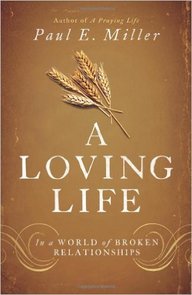
A Loving Life In a World of Broken Relationships by Paul E. Miller, available in several formats (including audio, my new fave) from Amazon. Also available through Crossway Books. He is on the staff of seeJesus.net, a Bible study ministry, and you can view his video teaching blog at Paul’s Weekly Teaching.
I have been privileged to go through Miller’s previous book, A Praying Life, with study groups on at least two occasions but had never read this one. I vaguely remember starting it at some point and thinking it was just too negative; it seemed to emphasize that love always involves suffering. Not what I wanted to hear! So I put it back on the shelf. But then this summer I was looking over our stock of Christian books for something to read in my morning quiet time and decided to give it another try.
I guess I must have changed, since Paul Miller hasn’t been seen sneaking into our house and switching books, because this time I was captivated. Not completely captivated, you understand. I still think he’s a bit of a downer in some ways. But hey. The guy has lived out what he teaches. He’s so transparent about his own life that you can’t help but pay attention to him. One person who shows up again and again in A Praying Life is his autistic daughter, Kim, who is now a young adult. She has never been able to talk and has to use a computer to communicate; listen to an interview with the two of them here on Family Life Today radio. You’ll get to hear Kim “speak.” She doesn’t appear as much in this book but there are still references to her as well as to many people whom Miller has counseled.
The book centers around the book of Ruth. He uses that beautiful and somewhat enigmatic story to weave together many threads. His ideas on love and sex will show up over on my “Personal and Political” page next week. But that’s a whole other discussion. His overwhelming emphasis is on the self-sacrificial nature of true love. So early in the book he tells the story of a woman named Leslie who “patiently endured with her wayward husband.” He had shown genuine repentance, but her family felt that she should not have stuck with him. So Miller deals with the rejection that this godly woman is now enduring for her former endurance. I wish I knew a little more about how much and how long she endured; how much is too much? how long is too long? That question is somewhat answered in a later example with a couple named Debbie and Robert. Robert leaves his wife and moves in with another woman. But he still wants to see Debbie; he misses her. And he misses his grandchildren. (Never too old for folly, it seems.) So Debbie and her daughter wisely withhold what Robert wants. He needs to see that he can’t have it both ways. To say, “I love Robert, and so I’ll go along with his demands” would have confirmed Robert in his sin. But Debbie also continues to pray for her husband, that God would bring him to the end of himself. She reminds herself constantly of Romans 12:12: “Be joyful in hope, patient in affliction, faithful in prayer.” And that’s what happens. As Miller admits, “It’s still hard to believe.” But Robert repents and admits his sin; he returns to his wife. That’s not what always happens; there’s no guarantee that the sinner will change. But what a beautiful story of both prudence and persistence in love!
Well, as always about a good book, there’s too much to say in this short post. I recommend that you read the book of Ruth in the Old Testament, looking particularly at the title character’s life, and then see what Miller has to say. It’s a wonderful journey.